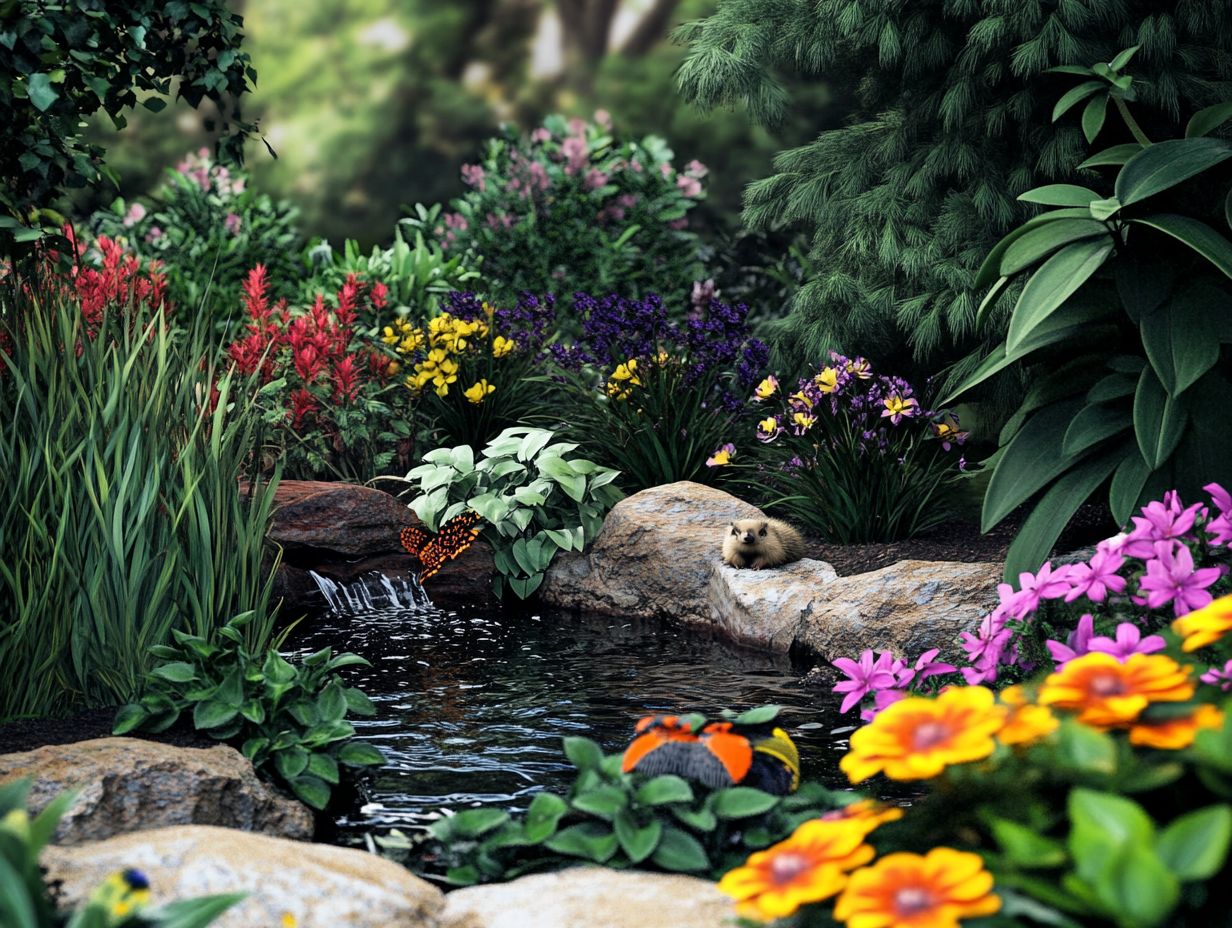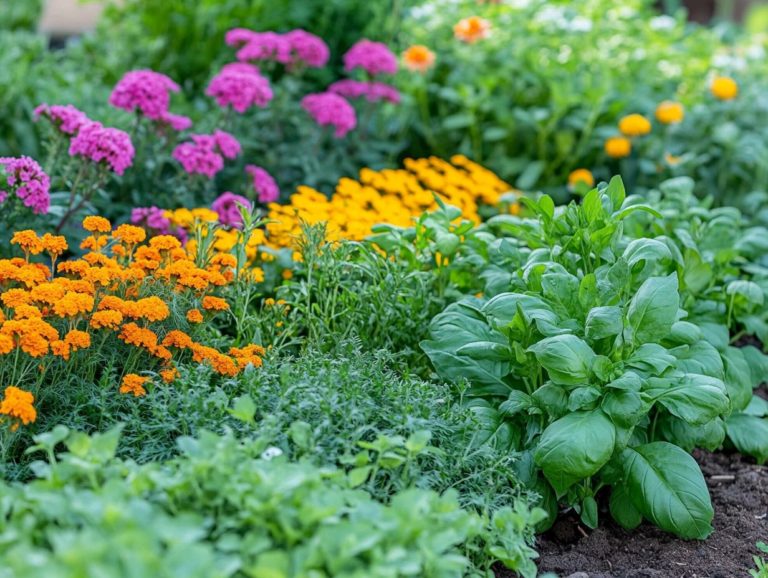How to Build a Wildlife-Friendly Garden
Creating a wildlife-friendly garden isn t merely about enhancing aesthetics; it s an essential step toward nurturing local ecosystems.
By designing spaces that cater to a variety of species, you can promote biodiversity and invite beneficial wildlife into your backyard.
This article delves into the numerous advantages of cultivating a wildlife-friendly garden. It offers practical tips for selecting native plants and habitats, and discusses effective ways to attract birds, bees, and butterflies.
Get ready to transform your garden into a true haven for nature!
Contents
- Key Takeaways:
- Why Create a Wildlife-Friendly Garden?
- Designing Your Garden with Wildlife in Mind
- Attracting Different Types of Wildlife
- Managing Pests and Maintaining Balance
- Creating a Sustainable and Eco-Friendly Garden
- Frequently Asked Questions
- 1. What is a wildlife-friendly garden?
- 2. Why should I build a wildlife-friendly garden and encourage pollinators?
- 3. What are some essential elements of a wildlife-friendly garden?
- 4. How can I incorporate native plants into my wildlife-friendly garden?
- 5. How can I make my wildlife-friendly garden more sustainable?
- 6. How can I maintain my wildlife-friendly garden?
Key Takeaways:

- Transform your space! A wildlife-friendly garden brings countless perks for local ecosystems, such as promoting biodiversity and providing natural habitats for various species.
- When designing your garden, choose native plants and incorporate water sources and shelter to attract different types of wildlife, including birds, bees, and butterflies.
- Use natural pest control methods and implement eco-friendly practices to maintain a balanced and thriving wildlife-friendly garden.
Why Create a Wildlife-Friendly Garden?
Creating a wildlife-friendly garden is not just a fulfilling journey; it’s a vital contribution to supporting local ecosystems and enhancing biodiversity.
By incorporating native plants and carefully designed habitats, you can attract a rich variety of garden wildlife. This includes vibrant birds, delicate butterflies, and beneficial insects. This exciting choice helps create a healthier environment for all!
In California, where natural habitats frequently face challenges, a wildlife garden becomes essential in promoting ecological balance and enriching your outdoor experience.
Benefits for Local Ecosystems
Creating a wildlife-friendly garden offers benefits that extend far beyond mere visual appeal. It significantly enriches local ecosystems and fosters biodiversity.
By incorporating native plants, you provide essential shelter and food sources for a variety of wildlife, from birds to small mammals. These gardens play a crucial role in supporting pollinators like bees and butterflies creatures that are crucial for the reproduction of many plants and the overall health of our environment.
Native plants also improve soil health, preventing erosion while boosting nutrient content. Both of these elements are essential for thriving ecosystems. Every element of a wildlife-friendly garden works in harmony, culminating in a balanced ecosystem that sustains diverse species and highlights the importance of preserving biodiversity in our ever-evolving world.
Designing Your Garden with Wildlife in Mind
Designing your garden with wildlife in mind requires thoughtful planning to create habitats that naturally entice a variety of species. This fosters a vibrant and sustainable ecosystem.
By carefully selecting native plant species like Silver birch, Guelder rose, and Jasmine, you enhance your garden’s biodiversity while supporting local wildlife.
Incorporating features such as compost heaps, bird feeders, and water sources will provide essential resources for these creatures. This transforms your garden into a flourishing retreat for both wildlife and yourself.
Choosing Native Plants and Habitats

Choosing native plants for your wildlife-friendly garden is essential. These plants thrive in your local conditions and ecosystems.
Imagine vibrant California Wisteria creating a stunning canopy for shelter. Colorful plants also attract Blackbirds and Butterflies, making your garden lively.
Flowering shrubs produce nectar, a sweet liquid that flowers produce to attract pollinators. Dense ground cover offers refuge for small creatures.
Your thoughtful selection of native plants will nurture biodiversity and enhance the overall vitality of your garden in California.
Incorporating Water Sources and Shelter
Incorporating water sources and shelter into your wildlife-friendly garden is essential for attracting a variety of animal species and fostering a vibrant ecosystem.
Consider adding various water features, such as serene ponds or delightful bird baths, which serve as vital hydration points for the diverse wildlife that visits your garden. These elements not only provide essential moisture but also draw in insects and birds, significantly contributing to pollination and natural pest control.
You can create cozy hideaways by installing structures like nesting boxes or incorporating lush shrubs. These shaded areas and protective spaces are crucial for offering solace to birds and small mammals, ultimately enhancing the overall health and resilience of your garden s ecosystem.
Attracting Different Types of Wildlife
Attracting a variety of wildlife to your garden is incredibly rewarding! You ll enhance your outdoor space and support local biodiversity.
By thoughtfully integrating elements that appeal to various species like nectar-rich plants for pollinators and fruit trees for birds you can transform your garden into a vibrant habitat brimming with life.
In California, welcoming an assortment of garden wildlife, including frogs and butterflies, not only elevates the aesthetic allure of your outdoor space but also plays a vital role in nurturing the health of local ecosystems.
Birds, Bees, Butterflies, and More
You can effectively attract birds, bees, butterflies, and various wildlife to your garden by carefully selecting the right combination of plant species and features tailored to their needs.
Each type of wildlife has its own unique preferences regarding food sources and nesting habitats. For example, hummingbirds flourish on nectar-rich plants like trumpet vine and bee balm, which provide essential sustenance. Butterflies, on the other hand, are drawn to flowers such as milkweed and coneflowers, which also serve as vital habitats for their larvae.
To create an inviting environment, think about incorporating water features, like shallow birdbaths or small ponds, to ensure they have access to hydration. Leaving certain areas undisturbed can favor ground-nesting birds, allowing a diverse range of wildlife to thrive.
With thoughtful planning and careful plant selection, your garden can transform into a vibrant haven for these cherished creatures.
Managing Pests and Maintaining Balance

Keeping pests in check while maintaining balance in your wildlife-friendly garden is crucial. It’s key for a healthy ecosystem!
Use natural pest control methods, like introducing ladybugs or using organic deterrents. This helps you maintain a healthy balance without harming the wildlife you want to attract.
By creating an environment where native plants and wildlife can flourish, you can effectively control pest populations while simultaneously promoting biodiversity.
Natural Pest Control Methods
Natural pest control methods are vital for maintaining a healthy, wildlife-friendly garden. They empower you to manage pests without jeopardizing beneficial species.
By incorporating practices like compost heaps, you create habitats that attract predatory insects. These insects are essential for naturally controlling pest populations. Use companion planting techniques to help your plants thrive together while keeping harmful bugs away. For instance, pairing marigolds with your vegetables boosts soil health and helps repel small garden pests.
These strategies benefit your plants and contribute to the well-being of local wildlife. This ensures your garden remains a balanced environment where both flora and fauna can flourish.
Creating a Sustainable and Eco-Friendly Garden
Establishing a sustainable and eco-friendly garden is essential to your goal of cultivating a wildlife-friendly space. This space nurtures local ecosystems and enriches biodiversity.
Using Organic and Non-Toxic Practices
Embracing organic and non-toxic practices in your wildlife-friendly garden cultivates a healthier environment, nurturing the well-being of the diverse wildlife that calls it home.
These methods such as composting rich organic materials, using natural fertilizers, and implementing eco-friendly pest management techniques work together to foster a balanced ecosystem. Composting enriches the soil with essential nutrients for your plants while reducing waste. This allows beneficial organisms to flourish. Natural fertilizers, sourced from plants or minerals, boost soil health without the harmful repercussions often linked to synthetic alternatives.
Thoughtful pest management, which avoids indiscriminate extermination, plays a crucial role in protecting vital insects like bees and ladybugs. These insects are essential for pollination and natural pest control. Start adopting these organic practices now to transform your garden!
Frequently Asked Questions

1. What is a wildlife-friendly garden?
A wildlife-friendly garden is designed to attract and support local wildlife, such as birds, butterflies, and other beneficial insects. It prioritizes using native plants, providing food, shelter, and water sources, while minimizing the use of chemicals and pesticides.
2. Why should I build a wildlife-friendly garden and encourage pollinators?
Building a wildlife-friendly garden supports local ecosystems and enhances your outdoor beauty. For those interested in creating such spaces, learning how to design for wildlife habitats can be invaluable. Attracting pollinators and other beneficial insects improves the health of your plants and reduces the need for chemical pesticides.
3. What are some essential elements of a wildlife-friendly garden?
Essential elements include native plants, a water source like a birdbath or small pond, and shelter in the form of trees, shrubs, and brush piles. Avoid using chemical pesticides and create varied habitats to attract different wildlife types.
4. How can I incorporate native plants into my wildlife-friendly garden?
Incorporating native plants is essential for attracting and supporting local wildlife. These plants are well adapted to the local climate and provide food and shelter for native animals and insects. Find a list of native plants for your area through your local garden center or online resources.
5. How can I make my wildlife-friendly garden more sustainable?
Make your garden more sustainable by reducing water usage. Choose drought-tolerant plants and use mulch to retain moisture. Avoid using chemical pesticides and fertilizers, and practice responsible gardening techniques like composting and proper waste disposal.
6. How can I maintain my wildlife-friendly garden?
Maintaining a wildlife-friendly garden requires regular care. This includes watering, weeding, and pruning when necessary.
Watch for signs of pests or diseases. Use natural methods to address these issues when possible.
Observing the wildlife in your garden helps you understand their needs. This knowledge allows you to continue supporting them effectively.
Want to create a haven for wildlife? Start by caring for your garden!






